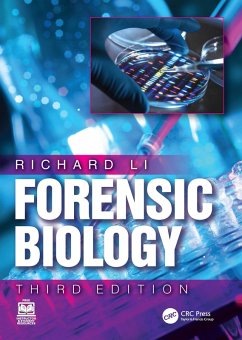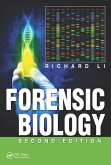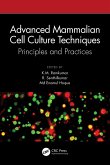Richard Li
Forensic Biology (eBook, PDF)
43,95 €
43,95 €
inkl. MwSt.
Sofort per Download lieferbar

22 °P sammeln
43,95 €
Als Download kaufen

43,95 €
inkl. MwSt.
Sofort per Download lieferbar

22 °P sammeln
Jetzt verschenken
Alle Infos zum eBook verschenken
43,95 €
inkl. MwSt.
Sofort per Download lieferbar
Alle Infos zum eBook verschenken

22 °P sammeln
Richard Li
Forensic Biology (eBook, PDF)
- Format: PDF
- Merkliste
- Auf die Merkliste
- Bewerten Bewerten
- Teilen
- Produkt teilen
- Produkterinnerung
- Produkterinnerung

Bitte loggen Sie sich zunächst in Ihr Kundenkonto ein oder registrieren Sie sich bei
bücher.de, um das eBook-Abo tolino select nutzen zu können.
Hier können Sie sich einloggen
Hier können Sie sich einloggen
Sie sind bereits eingeloggt. Klicken Sie auf 2. tolino select Abo, um fortzufahren.

Bitte loggen Sie sich zunächst in Ihr Kundenkonto ein oder registrieren Sie sich bei bücher.de, um das eBook-Abo tolino select nutzen zu können.
Forensic Biology, Third Edition provides students with a general understanding of forensic biology, particularly in forensic serology and forensic DNA analysis, and addresses rapid advancements in the field over the past few years.
- Geräte: PC
- mit Kopierschutz
- eBook Hilfe
- Größe: 125.99MB
Andere Kunden interessierten sich auch für
![Forensic Biology (eBook, ePUB) Forensic Biology (eBook, ePUB)]() Richard LiForensic Biology (eBook, ePUB)43,95 €
Richard LiForensic Biology (eBook, ePUB)43,95 €![Forensic Biology (eBook, PDF) Forensic Biology (eBook, PDF)]() Richard LiForensic Biology (eBook, PDF)76,95 €
Richard LiForensic Biology (eBook, PDF)76,95 €![Forensic Biology (eBook, ePUB) Forensic Biology (eBook, ePUB)]() Richard LiForensic Biology (eBook, ePUB)74,95 €
Richard LiForensic Biology (eBook, ePUB)74,95 €![Advanced Mammalian Cell Culture Techniques (eBook, PDF) Advanced Mammalian Cell Culture Techniques (eBook, PDF)]() Advanced Mammalian Cell Culture Techniques (eBook, PDF)50,95 €
Advanced Mammalian Cell Culture Techniques (eBook, PDF)50,95 €![Mechanisms Linking Aging, Diseases and Biological Age Estimation (eBook, PDF) Mechanisms Linking Aging, Diseases and Biological Age Estimation (eBook, PDF)]() Mechanisms Linking Aging, Diseases and Biological Age Estimation (eBook, PDF)49,95 €
Mechanisms Linking Aging, Diseases and Biological Age Estimation (eBook, PDF)49,95 €![Handbook of Proteases in Cancer (eBook, PDF) Handbook of Proteases in Cancer (eBook, PDF)]() Handbook of Proteases in Cancer (eBook, PDF)174,95 €
Handbook of Proteases in Cancer (eBook, PDF)174,95 €![Neurochemical Systems and Signaling (eBook, PDF) Neurochemical Systems and Signaling (eBook, PDF)]() Neurochemical Systems and Signaling (eBook, PDF)168,95 €
Neurochemical Systems and Signaling (eBook, PDF)168,95 €-
-
-
Forensic Biology, Third Edition provides students with a general understanding of forensic biology, particularly in forensic serology and forensic DNA analysis, and addresses rapid advancements in the field over the past few years.
Dieser Download kann aus rechtlichen Gründen nur mit Rechnungsadresse in A, B, BG, CY, CZ, D, DK, EW, E, FIN, F, GR, HR, H, IRL, I, LT, L, LR, M, NL, PL, P, R, S, SLO, SK ausgeliefert werden.
Produktdetails
- Produktdetails
- Verlag: Taylor & Francis eBooks
- Seitenzahl: 572
- Erscheinungstermin: 26. März 2025
- Englisch
- ISBN-13: 9781040261675
- Artikelnr.: 73302235
- Verlag: Taylor & Francis eBooks
- Seitenzahl: 572
- Erscheinungstermin: 26. März 2025
- Englisch
- ISBN-13: 9781040261675
- Artikelnr.: 73302235
- Herstellerkennzeichnung Die Herstellerinformationen sind derzeit nicht verfügbar.
Richard Li earned his MS in forensic science from the University of New Haven and his Ph.D. in molecular biology from the University of Wisconsin-Madison. After completing his Ph.D., Dr. Li was awarded a postdoctoral fellowship at Weill Medical College of Cornell University and subsequently worked as a research faculty member at the School of Medicine of Yale University. Dr. Li has also served as a criminalist at the Department of Forensic Biology in the Office of Chief Medical Examiner of New York City. For the past several decades, he has held faculty positions in forensic science programs in the United States. Currently, Dr. Li is a faculty member at John Jay College of Criminal Justice and also serves as a faculty member for the Ph.D. program in criminal justice at the college. His research interests include identification and analysis of biological specimens that are potentially useful in forensic investigations.
SECTION I Biological Evidence
Chapter 1 Crime Scene Investigation of Biological Evidence
Chapter 2 Crime Scene Bloodstain Pattern Analysis
Chapter 3 Forensic Biology: A Subdiscipline of Forensic Science
Chapter 4 Sources of Biological Evidence
SECTION II Basic Techniques in Forensic Biology
Chapter 5 Nucleic Acid Extraction
Chapter 6 DNA Quantification
Chapter 7 Nucleic Acid Amplification
Chapter 8 Basic Techniques for Length Polymorphism Analysis
Chapter 9 Basic Techniques for Sequence Polymorphism Analysis
Chapter 10 Serology Concepts
Chapter 11 Forensic Serology Techniques
Chapter 12 Emerging Body Fluid Identification Techniques
SECTION III Identification of Biological Evidence
Chapter 13 Identification of Blood
Chapter 14 Identification of Semen
Chapter 15 Identification of Saliva
Chapter 16 Identification of Vaginal Secretions and Menstrual Blood
Chapter 17 Identification of Other Body Fluids and Cellular Materials
SECTION IV Individualization of Biological Evidence
Chapter 18 Blood Group Typing and Protein Profiling
Chapter 19 Variable Number Tandem Repeat Profiling
Chapter 20 Autosomal Short Tandem Repeat Profiling
Chapter 21 Sex Chromosome Haplotyping and Identification
Chapter 22 Single Nucleotide Polymorphism Profiling
Chapter 23 Mitochondrial DNA Profiling
SECTION V Forensic Issues
Chapter 24 Forensic DNA Databases: Tools for Crime Investigations
Chapter 25 Evaluation of the Strength of Forensic DNA Profiling Results
Chapter 26 Standards and Qualifications
Chapter 1 Crime Scene Investigation of Biological Evidence
Chapter 2 Crime Scene Bloodstain Pattern Analysis
Chapter 3 Forensic Biology: A Subdiscipline of Forensic Science
Chapter 4 Sources of Biological Evidence
SECTION II Basic Techniques in Forensic Biology
Chapter 5 Nucleic Acid Extraction
Chapter 6 DNA Quantification
Chapter 7 Nucleic Acid Amplification
Chapter 8 Basic Techniques for Length Polymorphism Analysis
Chapter 9 Basic Techniques for Sequence Polymorphism Analysis
Chapter 10 Serology Concepts
Chapter 11 Forensic Serology Techniques
Chapter 12 Emerging Body Fluid Identification Techniques
SECTION III Identification of Biological Evidence
Chapter 13 Identification of Blood
Chapter 14 Identification of Semen
Chapter 15 Identification of Saliva
Chapter 16 Identification of Vaginal Secretions and Menstrual Blood
Chapter 17 Identification of Other Body Fluids and Cellular Materials
SECTION IV Individualization of Biological Evidence
Chapter 18 Blood Group Typing and Protein Profiling
Chapter 19 Variable Number Tandem Repeat Profiling
Chapter 20 Autosomal Short Tandem Repeat Profiling
Chapter 21 Sex Chromosome Haplotyping and Identification
Chapter 22 Single Nucleotide Polymorphism Profiling
Chapter 23 Mitochondrial DNA Profiling
SECTION V Forensic Issues
Chapter 24 Forensic DNA Databases: Tools for Crime Investigations
Chapter 25 Evaluation of the Strength of Forensic DNA Profiling Results
Chapter 26 Standards and Qualifications
SECTION I Biological Evidence
Chapter 1 Crime Scene Investigation of Biological Evidence
Chapter 2 Crime Scene Bloodstain Pattern Analysis
Chapter 3 Forensic Biology: A Subdiscipline of Forensic Science
Chapter 4 Sources of Biological Evidence
SECTION II Basic Techniques in Forensic Biology
Chapter 5 Nucleic Acid Extraction
Chapter 6 DNA Quantification
Chapter 7 Nucleic Acid Amplification
Chapter 8 Basic Techniques for Length Polymorphism Analysis
Chapter 9 Basic Techniques for Sequence Polymorphism Analysis
Chapter 10 Serology Concepts
Chapter 11 Forensic Serology Techniques
Chapter 12 Emerging Body Fluid Identification Techniques
SECTION III Identification of Biological Evidence
Chapter 13 Identification of Blood
Chapter 14 Identification of Semen
Chapter 15 Identification of Saliva
Chapter 16 Identification of Vaginal Secretions and Menstrual Blood
Chapter 17 Identification of Other Body Fluids and Cellular Materials
SECTION IV Individualization of Biological Evidence
Chapter 18 Blood Group Typing and Protein Profiling
Chapter 19 Variable Number Tandem Repeat Profiling
Chapter 20 Autosomal Short Tandem Repeat Profiling
Chapter 21 Sex Chromosome Haplotyping and Identification
Chapter 22 Single Nucleotide Polymorphism Profiling
Chapter 23 Mitochondrial DNA Profiling
SECTION V Forensic Issues
Chapter 24 Forensic DNA Databases: Tools for Crime Investigations
Chapter 25 Evaluation of the Strength of Forensic DNA Profiling Results
Chapter 26 Standards and Qualifications
Chapter 1 Crime Scene Investigation of Biological Evidence
Chapter 2 Crime Scene Bloodstain Pattern Analysis
Chapter 3 Forensic Biology: A Subdiscipline of Forensic Science
Chapter 4 Sources of Biological Evidence
SECTION II Basic Techniques in Forensic Biology
Chapter 5 Nucleic Acid Extraction
Chapter 6 DNA Quantification
Chapter 7 Nucleic Acid Amplification
Chapter 8 Basic Techniques for Length Polymorphism Analysis
Chapter 9 Basic Techniques for Sequence Polymorphism Analysis
Chapter 10 Serology Concepts
Chapter 11 Forensic Serology Techniques
Chapter 12 Emerging Body Fluid Identification Techniques
SECTION III Identification of Biological Evidence
Chapter 13 Identification of Blood
Chapter 14 Identification of Semen
Chapter 15 Identification of Saliva
Chapter 16 Identification of Vaginal Secretions and Menstrual Blood
Chapter 17 Identification of Other Body Fluids and Cellular Materials
SECTION IV Individualization of Biological Evidence
Chapter 18 Blood Group Typing and Protein Profiling
Chapter 19 Variable Number Tandem Repeat Profiling
Chapter 20 Autosomal Short Tandem Repeat Profiling
Chapter 21 Sex Chromosome Haplotyping and Identification
Chapter 22 Single Nucleotide Polymorphism Profiling
Chapter 23 Mitochondrial DNA Profiling
SECTION V Forensic Issues
Chapter 24 Forensic DNA Databases: Tools for Crime Investigations
Chapter 25 Evaluation of the Strength of Forensic DNA Profiling Results
Chapter 26 Standards and Qualifications







